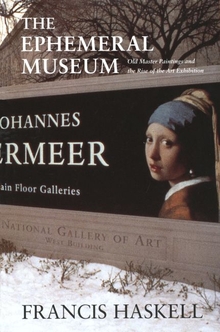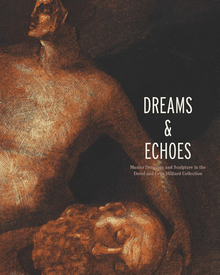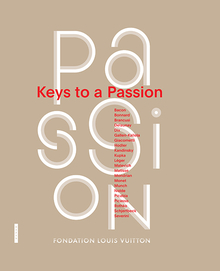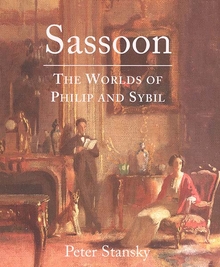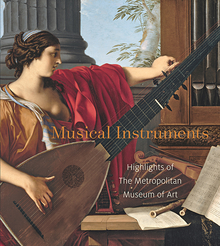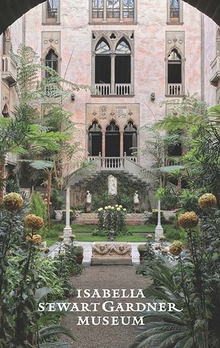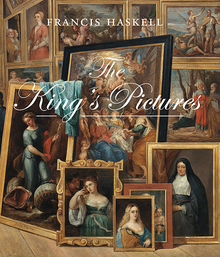The Ephemeral Museum
WARNING
You are viewing an older version of the Yalebooks website. Please visit out new website with more updated information and a better user experience: https://www.yalebooks.com
Old Master Paintings and the Rise of the Art Exhibition
Francis Haskell
When and why did large-scale exhibitions of Old Master paintings begin, and how have they evolved through the centuries? In this book an eminent art historian examines the intriguing history and significance of these international art exhibitions.
Francis Haskell begins by discussing the first “Old Master” exhibitions in Rome and Florence in the seventeenth century and then moves to eighteenth-century France and the efforts to organize exhibitions of contemporary art that would be an alternative to the official ones held by the Salon. He next describes the role of the British Institution in London and the series of remarkable loan exhibitions of Old Master paintings there. He traces the emergence of such nationalist exhibitions as the Rembrandt exhibition held in Amsterdam in 1898, the first modern “blockbuster” exhibit. Demonstrating how the international loan exhibition was a vehicle of foreign and cultural policy after the First World War, he gives a fascinating account of several of these, for example the Italian Art exhibition held at Burlington House in 1930 (Botticelli in the Service of Fascism). He describes the initial reluctance of major museums to send pictures on potentially damaging journeys and explains how this feeling gave way to cautious enthusiasm. Finally, in a polemical chapter, he explores the type of publications associated with exhibitions and with the criticism and scholarship that have centered upon them.
Francis Haskell begins by discussing the first “Old Master” exhibitions in Rome and Florence in the seventeenth century and then moves to eighteenth-century France and the efforts to organize exhibitions of contemporary art that would be an alternative to the official ones held by the Salon. He next describes the role of the British Institution in London and the series of remarkable loan exhibitions of Old Master paintings there. He traces the emergence of such nationalist exhibitions as the Rembrandt exhibition held in Amsterdam in 1898, the first modern “blockbuster” exhibit. Demonstrating how the international loan exhibition was a vehicle of foreign and cultural policy after the First World War, he gives a fascinating account of several of these, for example the Italian Art exhibition held at Burlington House in 1930 (Botticelli in the Service of Fascism). He describes the initial reluctance of major museums to send pictures on potentially damaging journeys and explains how this feeling gave way to cautious enthusiasm. Finally, in a polemical chapter, he explores the type of publications associated with exhibitions and with the criticism and scholarship that have centered upon them.
Francis Haskell, who died in January 2000, was one of the most original and influential art historians of the twentieth century. His books included Patrons and Painters, Past and Present in Art and Taste, History and Its Images, and, with Nicholas Penny, Taste and the Antique, all published by Yale University Press. He retired as professor of the history of art at Oxford University in 1995.
“This fascinating volume presents much evidence of the importance of studying the history of exhibitions. And in this, there is no better guide than Francis Haskell.”—Bruce Altshuler, Art & Auction
“Haskell’s lucidly written history opens with the temporary exhibitions of works by past masters in the churches of 17th-century Rome and closes with some serious reservations about the value of these shows today. . . . His tone is often tart: his breadth of knowledge breathtaking. This is an absorbing narrative, accessible even to amateur aficionados of art history.”—Ann Landi, Art News
“[Haskell’s] breadth of approach and consideration of all aspects of works of art, particularly historical and social, have literally transformed contemporary art history. . . . His command of history and politics, as well as his concern with exhibitions in Italy, France, England, and Holland in particular, are breathtaking. . . . [He] writes provocatively with an unparalleled command of all aspects of the subject. . . . An important publication. . . . Highly recommended.”—Choice
“Francis Haskell was one of the most original art historians of our time. His books were pioneering, and The Ephemeral Museum which has been published posthumously, is no exception.”—Christopher Lloyd, Country Life
“One of the few sources to describe the evolution of exhibition catalogs, this book will…appeal most to students of art history and museum studies but also may be of interest to readers in the social sciences.”—Library Journal
“Chapters on the unconscionable propagandistic uses to which art was subjected under Napoleon’s reign, the commercial vectors involved in the international dispersal of private and princely collections in the late-eighteenth and nineteenth centuries, as well as the rise of more explicitly political and national pretenses for such exhibitions offer a richly instructive series of episodes that condense his larger themes into discrete events. This has always been a hallmark of Haskell’s scholarly approach: exactingly concrete examinations of the social dimensions of artistic practices without a hint of what is now de rigueur--leftist ideological sermonizing.”— J. Duncan Berry, New Criterion
“There is here occasion for intense pleasure and regret: all that learning cut short, and that passionate advocacy quelled.”—James Fenton, New York Review of Books
“In this fascinating study of the rise and inexorable triumph of the temporary art exhibition, the late art historian traces the influence that politics, commerce, and nationalism (and, to be fair, altruism) had on the international boom in travelling shows of the Old Master paintings. . . . Splendid.”—New Yorker
“In nine chapters devoted to specific exhibits, Haskell goes behind the scenes, delving through miles of source materials to explain the political context for many of the shows. . . . Haskell’s clear prose brings what is often a highly detailed and specialist discussion into clear focus.”—Publishers Weekly
“An absorbing story, told with great lucidity and enhanced by meticulous research and strongly expressed views.”—Evelyn Joll, Spectator
“Some fascinating answer--as well as many provocative questions--are provided in The Ephemeral Museum, the book Francis Haskell was completing when he died early this year, now published with commendable and remarkable speed.”—The Burlington Magazine
“One of the truly original art historians of the age has left us a brilliant and disturbing book that asks if blockbuster shows are ruining great museums.”—The Economist
“The resonances of [the] last passage are almost unbearably poignant, but the tone of the book is pointed, erudite, original and funny: a fitting memorial to Haskell’s own enduring legacy in illuminating cultural attitudes by showing the way art has been seen through history.”—Roy Foster, Times Literary Supplement
“The Ephemeral Musuem is . . . ever fascinating, wisely exploring issues at the heart of the social history of art.”—Richard E. Spear, Washington Post Book World
ISBN: 9780300085341
Publication Date: November 10, 2000
Publication Date: November 10, 2000
224 pages, 6 x 9 1/4
60 b/w illus.
60 b/w illus.

